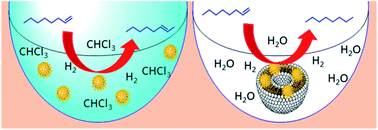Effects of lipid bilayer encapsulation and lipid composition on the catalytic activity and colloidal stability of hydrophobic palladium nanoparticles in water†
Abstract
This article shows the preparation of a lipid-nanoparticle assembly (LNA) which contains hydrophobic palladium nanoparticles (PdNPs) within the hydrophobic regions of the liposomal micelles. To understand the colloidal stability and catalytic activity of LNAs, the structure–property relationships of LNAs are investigated by manipulating the lipid composition and reaction temperature. The studies of LNAs using dynamic light scattering (DLS), differential scanning calorimetry (DSC), and transmission electron microscopy (TEM) show decreased colloidal stability with the incorporation of PdNPs compared to their counterpart 1,2-distearoyl-sn-glycero-3-phosphocholine (DSPC) liposomes without PdNPs. LNAs with PdNPs catalyze the hydrogenation of 1-octene and its isomers to octane under one atm hydrogen gas and at room temperature within 24 h. The kinetic studies show that the isomerization of 1-octene to 2-octene occurs more favorably in the early stage of the reactions, which is followed by the subsequent hydrogenation of all octene isomers. The studies on temperature effects indicate that there is a significant increase in conversion yield of substrates when the reaction temperature increases from 22 to 37 °C, which correspond to room temperature and biological temperature, respectively. Phase transition of DSPC-PdNP LNAs from gel to liquid crystalline phase changing the fluidity of the bilayer is proposed to be the main reason for dramatic increases in the catalytic activity of the LNAs. It is also found that the rate of hydrogenation is dependent on the lipid composition of LNAs with the presence of cholesterol having a negative influence on the catalytic activity of LNAs while increasing their colloidal stability.



 Please wait while we load your content...
Please wait while we load your content...